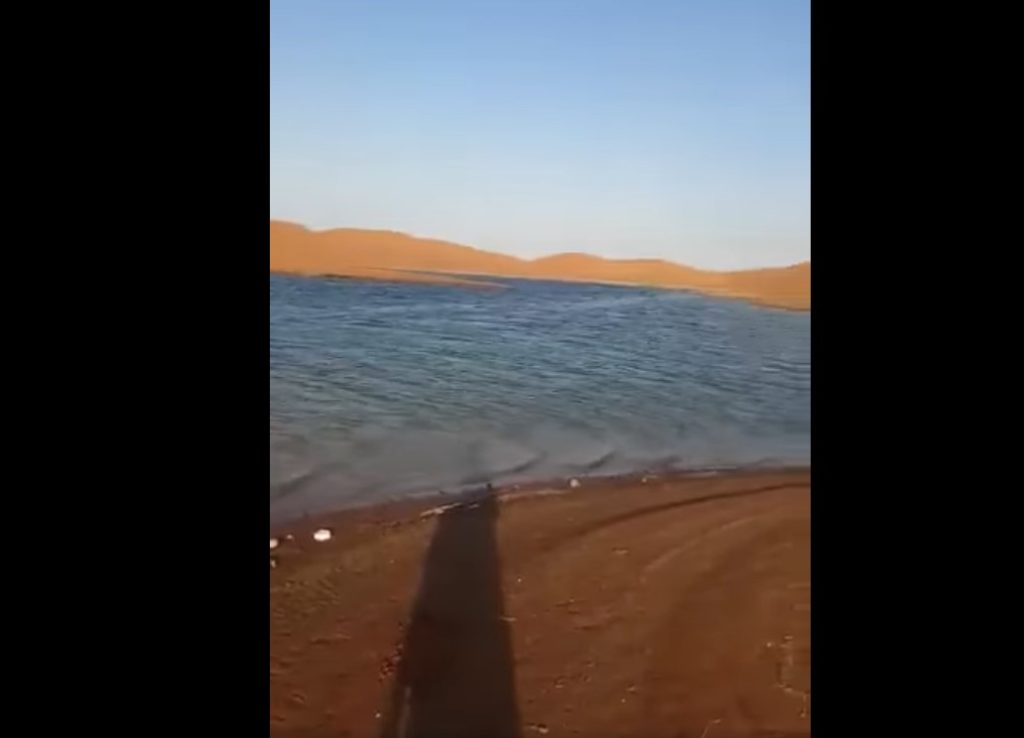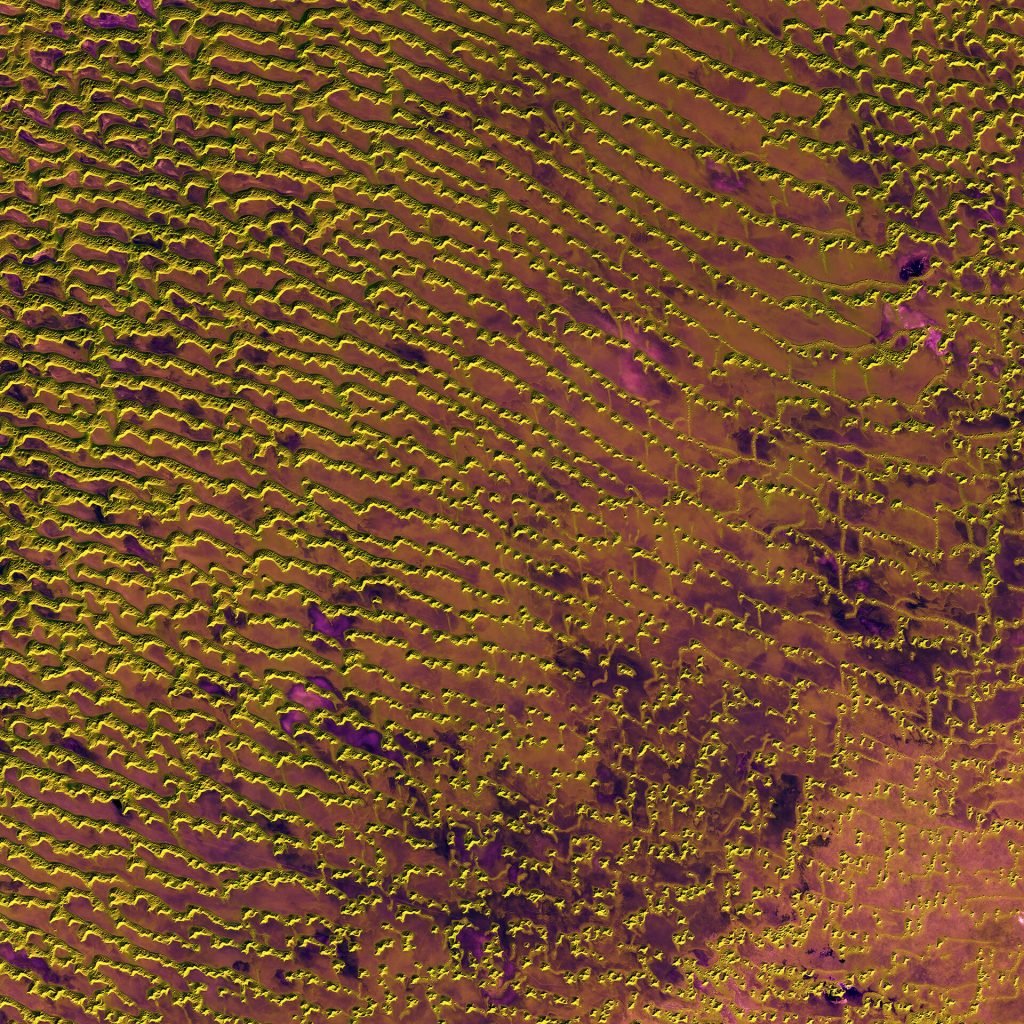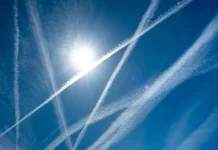
Isaiah 41:18 “I will make rivers flow on barren heights, and springs within the valleys. I will turn the desert into pools of water, and the parched ground into springs.”
A beautiful lake formed in the Empty Quarter desert on the border between Saudi Arabia and Oman after heavy rains and the flow of valleys due to Hurricane Shaheen.
The same desert lake phenomenon took place about 3 years ago after Cyclone Mekunu in a rare phenomenon that had not happened in nearly 20 years at the time!
What is the Rub’ al Khali desert?
Also known at the ‘Empty Quarter’, the Rub’ al Khali is the largest contiguous sand desert in the world. Precipitation rarely exceeds 35 mm a year and regular high temperatures are around 50°C.

The yellow lines and dots in this false-colour image are sand dunes. Looking closer at the dunes in the lower right, many have three or more ‘arms’ shaped by changing wind directions and are known as ‘star dunes’. They tend to ‘grow’ upwards rather than laterally, and reach up to 250 m in height in some parts of the Rub’ al Khali.
The dunes are interspersed with hardened flat plains – remnants of shallow lakes that existed thousands of years ago, formed by monsoon-like rains and runoff.
The multispectral instrument on Sentinel-2 uses parts of the infrared spectrum to detect subtle changes in vegetation cover, but can also see changes in mineral composition where vegetation is sparse. In this image, shades of brown to bright purple show the mineral composition, possibly including salt or gypsum.
In any cases, it seems like The Empty Quarter is no longer empty! [ESA, Facebook]
Now subscribe to this blog to get more amazing news curated just for you right in your inbox on a daily basis (here an example of our new newsletter).
You can also follow us on Facebook and/ or Twitter. And, by the way you can also make a donation through Paypal. Thank you!
You should really subscribe to QFiles. You will get very interesting information about strange events around the world.














‘World’s largest’ nabkha discovered in UNESCO-tagged Lut Desert
TEHRAN – The “world’s largest” nabkha (coppice dune) has recently been discovered within the UNESCO-registered Lut Desert in the barren heartland of Iran, the director of the World Heritage site has announced.
Having a height of 21 meters, the recently discovered nabkha is taller than those in Africa and some desert regions of the world, IRNA quoted Mehran Maqsudi as saying on Monday.
Before this discovery, other nabkhas that are found in Lut Desert and are 11 to 12 meters high, were considered some of the tallest in the world, the official explained.
The outcome of this field research and discovery has been published in reputable scientific journals in the form of a scientific article with details, he added.
One of the spectacular phenomena of the Lut Desert is nabkha, also known as coppice dune, shrub-coppice, hummock, rebdou, or photogenic mound.
The creation of nabaka is closely linked to the type of plant, wind direction, and the amount of sand source. In the desert lands, everything is created from wind and soil erosion and saltwater, but nabkha symbolizes the synergy of the plants and the arid region of the Lut Desert.
Lut Desert and Sahara in Africa are the only places in the world that nabkha are observed. Nabkha is generally found on flat surfaces with moderate sand levels and high groundwater levels or enough moisture to grow plants.
These natural phenomena are a result of the interaction of wind erosion, moisture, and vegetation of the area. The plants gradually from sand dunes at the bottom by obstructing the sand storm and accumulating sand.
The origin of nabkha is the plants, however, it can be considered that nabakha will be formed in all desert lands where vegetable life is in progress.
Nabakha’s shape is a function of the size, density, and growth of the host plant. There is a type of Tamarisk tree in the region that is the main host of the nabkha. These Tamarisk trees must have a height of 10 to 15 centimeters in length at least to be able to control the sand.
If the sand grains do not adhere to the clay elements, their volume might be changed by variations of wind speed. By increasing the amount of sand at the foot of the plant, the plant continues to grow in an upward direction to prevent its burial. The plant continues growing as well as the plant’s root is connected to the groundwater level. But where the groundwater level drops, nabkha dies.
Lut Desert, the hottest spot on Earth
The Lut Desert, widely referred to as Dasht-e Lut (“Emptiness Plain”), is a large salt desert encircled by the provinces of Kerman and Sistan- Baluchestan, and South Khorasan. It is the world’s 27th-largest desert and was inscribed on UNESCO’s World Heritage List on July 17, 2016.
The Lut Desert is teemed with giant dunes, shifting sands, salt plains, and wind-hewn kaluts, offering visitors epic journeys of breathtaking beauty and wilderness. It is a destination for people who are in search of new adventures; outstanding scenery and unparalleled serenity
The scorching desert is also being considered one of the top areas in the world for finding meteorites, thanks to its unique parameters. In recent years, significant finds have been made, with the efforts of national and international teams of researchers.
Seven years of satellite temperature data analyzed by NASA show that the Lut Desert is the hottest spot on Earth. Based on the research, it was the hottest during 5 of the 7 years and had the highest temperature overall: 70.7°C in 2005.
Islam cut the heads of its citizens world wide is not Islam any more is a cult it is duty every Muslim to get out of it? Taliban ISIS and Ayatollahs and Saudis all have same commonality they kill? Mohamed was married to a 6 years old girl, would you give your daughter to a 60 years old man? If you do is then you go to prison indeed for life?
That happens in low lying areas after flash floods too. It’s great. Toads come out, and breed like crazy. That’s their big chance to be fruitful, and multiply. Some years they never come out unless there are big rains. At night, you can hear their mating calls.
One thing you have to be careful about. If you have dogs, put them on leash even if you live way far away. Sometimes dogs will grab those toads in their mouth, and the poison is in the toads glands. What happens is the impulse to secrete poison is caused by an attack on the toad. It’s a defense mechanism.
It can kill a dog. So, be advised.
I tried some on 11″ bamboo blowgun darts.
https://www.thegatewaypundit.com/2021/10/watch-north-carolina-lt-gov-says-wont-bow-pressure-resign-blasting-schools-teaching-graphic-sexual-concepts-kids/
Hahahaha, give him a medal!
https://www.infowars.com/posts/videos-italians-fight-back-against-violent-police-while-protesting-vaccine-mandates/
Italian people in the thousands protesting tyranny. Police beating on people. Looks bad for tyrants. Don’t forget what happened to Benito Mussolini.
Kudos for Italian Protesters!
https://www.thegatewaypundit.com/2021/10/exclusive-reports-uncovered-show-covid-19-planned-bioweapon-chinas-peoples-liberation-army/
Just like I said 18 months ago. This is an act of war too. Our traitors share responsibility with redchineseys.
Probably nothing will happen since rinos and lefties are bribed, extorted, or compromised.
https://humansarefree.com/2021/10/nearly-all-covid-deaths-occurring-in-fully-vaccinated.html
Majority of vax deaths (80-81%) Aug/Sept are vaxxed sheeple.
Oooops, looks like eugenics to me.
https://www.thegatewaypundit.com/2021/10/netflix-suspends-transgender-employee-tried-get-comedian-dave-chappelle-cancelled/
Well, netflix promoted that cheerleading pedo show, so they’re in bed with satan. This creature is disgusting. These were known as transvestites in the 70’s. There’s some mental illness right there. Norman Bates material.
Most of America doesn’t want to participate in this mental illness. Keep your perversions to yourself.
https://www.thegatewaypundit.com/2021/10/bidens-called-vaccine-mandate-jeopardizes-millions-jobs-doesnt-exist-mirage/
Vax mandate is nothing but bozobiden bluster.
No legal standing. Sue your corporate communist employer if you are forced out of your job. They want to bankrupt you, so you can sue, and bankrupt them.